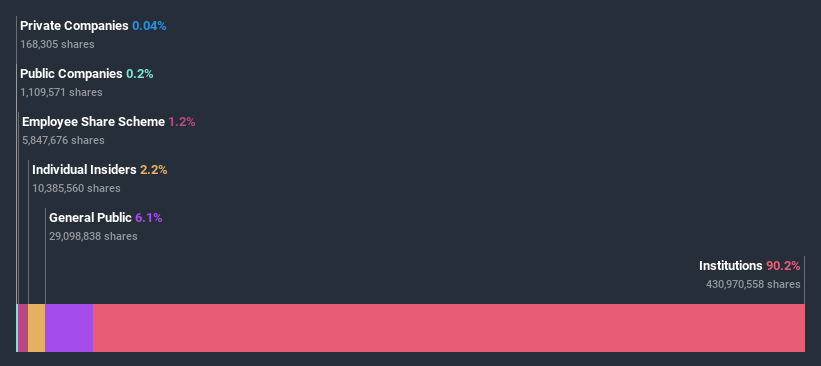How Many Trainline Plc (LON:TRN) Shares Do Institutions Own?

Every investor in Trainline Plc ( LON:TRN ) should be aware of the most powerful shareholder groups. Institutions often own shares in more established companies, while it's not unusual to see insiders own a fair bit of smaller companies. Companies that used to be publicly owned tend to have lower insider ownership.
Trainline isn't enormous, but it's not particularly small either. It has a market capitalization of UK£1.7b, which means it would generally expect to see some institutions on the share registry. Our analysis of the ownership of the company, below, shows that institutional investors have bought into the company. Let's delve deeper into each type of owner, to discover more about Trainline.
Check out our latest analysis for Trainline
What Does The Institutional Ownership Tell Us About Trainline?
Institutions typically measure themselves against a benchmark when reporting to their own investors, so they often become more enthusiastic about a stock once it's included in a major index. We would expect most companies to have some institutions on the register, especially if they are growing.
We can see that Trainline does have institutional investors; and they hold a good portion of the company's stock. This suggests some credibility amongst professional investors. But we can't rely on that fact alone since institutions make bad investments sometimes, just like everyone does. When multiple institutions own a stock, there's always a risk that they are in a 'crowded trade'. When such a trade goes wrong, multiple parties may compete to sell stock fast. This risk is higher in a company without a history of growth. You can see Trainline's historic earnings and revenue below, but keep in mind there's always more to the story.
Since institutional investors own more than half the issued stock, the board will likely have to pay attention to their preferences. Hedge funds don't have many shares in Trainline. Baillie Gifford & Co. is currently the largest shareholder, with 12% of shares outstanding. In comparison, the second and third largest shareholders hold about 12% and 11% of the stock. Furthermore, CEO Clare Gilmartin is the owner of 1.6% of the company's shares.
We also observed that the top 7 shareholders account for more than half of the share register, with a few smaller shareholders to balance the interests of the larger ones to a certain extent.
While it makes sense to study institutional ownership data for a company, it also makes sense to study analyst sentiments to know which way the wind is blowing. There are plenty of analysts covering the stock, so it might be worth seeing what they are forecasting, too.
Insider Ownership Of Trainline
The definition of an insider can differ slightly between different countries, but members of the board of directors always count. The company management answer to the board and the latter should represent the interests of shareholders. Notably, sometimes top-level managers are on the board themselves.
Insider ownership is positive when it signals leadership are thinking like the true owners of the company. However, high insider ownership can also give immense power to a small group within the company. This can be negative in some circumstances.
We can see that insiders own shares in Trainline Plc. The insiders have a meaningful stake worth UK£38m. Most would see this as a real positive. It is good to see this level of investment by insiders. You can check here to see if those insiders have been buying recently.
General Public Ownership
The general public holds 6.1% stake in Trainline, which represents a relatively small class of owners. Thus, only a relatively small part of the company is held by retail investors. Since they are only a small group of shareholders in the company, there's little they can do if their interests are not prioritized.
Next Steps:
It's always worth thinking about the different groups who own shares in a company. But to understand Trainline better, we need to consider many other factors. To that end, you should be aware of the 2 warning signs we've spotted with Trainline .
But ultimately it is the future , not the past, that will determine how well the owners of this business will do. Therefore we think it advisable to take a look at this free report showing whether analysts are predicting a brighter future .
NB: Figures in this article are calculated using data from the last twelve months, which refer to the 12-month period ending on the last date of the month the financial statement is dated. This may not be consistent with full year annual report figures.




